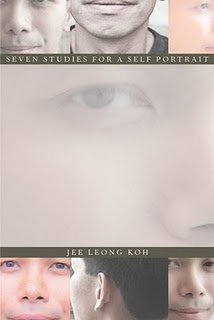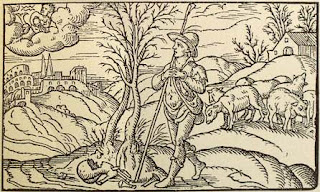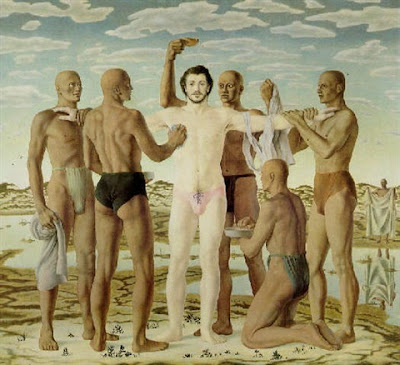Seven Studies for a Self Portrait: Part 1 (of 7).

Jee Leong Koh’s new book of poetry is a significant work. But significant in how many ways? The literary critic, Nicholas Liu, describes it as a “mighty book” for Singaporean literature. This he is well qualified to judge. I believe it is no less a great book in terms of gay poetry— a statement which needs explanation given the current dissatisfaction with the term gay poetry. And a forceful book in terms of Hermeticism— a claim which is probably going to need just as much clarification.
Reginald Shepherd said almost everything that needed to be said in his attack on identity poetics. A poetics that exists to push a gay agenda serves the wrong god. The Greeks ascribed poetry to Apollo, not Eros. A poet must be first and foremost a poet. His allegiance is to creativity, not fucking. But a writer who is prepared to push his sexuality to the margins and declare himself a writer who happens to be gay, as if his core is an accidental, also makes an error. In the High Renaissance, Hermes, the god of writing, became a cipher for the link between overworld and underworld, between inspiration and dark (homo)erotic desire. I don’t see the term gay poet as a belittling term in anyway: such simply honours a twinning, a Hermetic union. Jee Leong Koh serves Hermes, and in doing so his new book is a disciplined work about sexuality and poetry: it is written with a technical passion.
Seven Studies for a Self Portrait opens with a quotation from Nietzsche’s Thus Spake Zarathustra (1891):
And this is all my creating and striving, that I create and carry together into One what is fragment and riddle and dreadful accident.
In reviewing SSfaSP, Nicholas Liu reads this epigram in terms of self-identity. This leads him to add a qualification to the “mighty book”. He states that the book fails to “present the magisterial composite of the self” proposed by Nietzsche. Perhaps, he is correct, but perhaps the author never intended to reach the dizzying heights of complete self-awareness. (Nicholas Liu, to his credit, does revise his initial view and suggest that the Nietzsche is a decoy). Perhaps, Nicholas Liu has also misread the meaning of Zarathustra. To “carry together into One” is a re-statement of the Hermetic “Many-in-One”. And to transport bits and pieces of trickery into Unity is clearly an echo of Hermes’ working methods: he was both trickster, maker of mistakes, and unveiler of secrets. Behind Zarathustra’s declaration (the epigram above) there is a passage from The Gay Science (1882) in which Nietzsche speaks of how weakness and strength must be assimilated into one…by the writer…who is interested in “giving style”, who seeks to identify himself through artistic organisation. The novelist who most recognised this, in the last century, was Herman Hesse. Hermes was his guiding genius; especially in his master-work on mystical artistry, Das Glasperlenspiel. Like Aeschylus, he encounterd Hermes as "Master of the Game". In a recent interview, Jee Leong Koh acknowledges that he sees poetry as Hesse’s “glass bead game”. It would be more accurate to read the Zarathustra quotation, not as a quest for total psychological wholeness, but as Jee Leong Koh’s belief in artistic style and integrity. SSfaSP is a book about “giving style” and accepting that every little thing, strong or weak, has its place in poetic life. The Nietzsche quotation recognises the poetic aims of the book: it is built from “riddles”, “I am My Names”; from “dreadful accident”, “Bull Eclogues”; and fragments, “A Lover’s Recourse” pays tribute to Roland Barthes’s A Lover’s Discourse, which is subtitled “Fragments”-- a book that is about the style of “accidents…and the amorous subject” (p.6). In "giving style", Jee leong Koh is concerned with what poetics can teach him (as a teacher in daily life) about love and relationship (to himself and others). Hermes, Apollo, Eros.
Reginald Shepherd said almost everything that needed to be said in his attack on identity poetics. A poetics that exists to push a gay agenda serves the wrong god. The Greeks ascribed poetry to Apollo, not Eros. A poet must be first and foremost a poet. His allegiance is to creativity, not fucking. But a writer who is prepared to push his sexuality to the margins and declare himself a writer who happens to be gay, as if his core is an accidental, also makes an error. In the High Renaissance, Hermes, the god of writing, became a cipher for the link between overworld and underworld, between inspiration and dark (homo)erotic desire. I don’t see the term gay poet as a belittling term in anyway: such simply honours a twinning, a Hermetic union. Jee Leong Koh serves Hermes, and in doing so his new book is a disciplined work about sexuality and poetry: it is written with a technical passion.
Seven Studies for a Self Portrait opens with a quotation from Nietzsche’s Thus Spake Zarathustra (1891):
And this is all my creating and striving, that I create and carry together into One what is fragment and riddle and dreadful accident.
In reviewing SSfaSP, Nicholas Liu reads this epigram in terms of self-identity. This leads him to add a qualification to the “mighty book”. He states that the book fails to “present the magisterial composite of the self” proposed by Nietzsche. Perhaps, he is correct, but perhaps the author never intended to reach the dizzying heights of complete self-awareness. (Nicholas Liu, to his credit, does revise his initial view and suggest that the Nietzsche is a decoy). Perhaps, Nicholas Liu has also misread the meaning of Zarathustra. To “carry together into One” is a re-statement of the Hermetic “Many-in-One”. And to transport bits and pieces of trickery into Unity is clearly an echo of Hermes’ working methods: he was both trickster, maker of mistakes, and unveiler of secrets. Behind Zarathustra’s declaration (the epigram above) there is a passage from The Gay Science (1882) in which Nietzsche speaks of how weakness and strength must be assimilated into one…by the writer…who is interested in “giving style”, who seeks to identify himself through artistic organisation. The novelist who most recognised this, in the last century, was Herman Hesse. Hermes was his guiding genius; especially in his master-work on mystical artistry, Das Glasperlenspiel. Like Aeschylus, he encounterd Hermes as "Master of the Game". In a recent interview, Jee Leong Koh acknowledges that he sees poetry as Hesse’s “glass bead game”. It would be more accurate to read the Zarathustra quotation, not as a quest for total psychological wholeness, but as Jee Leong Koh’s belief in artistic style and integrity. SSfaSP is a book about “giving style” and accepting that every little thing, strong or weak, has its place in poetic life. The Nietzsche quotation recognises the poetic aims of the book: it is built from “riddles”, “I am My Names”; from “dreadful accident”, “Bull Eclogues”; and fragments, “A Lover’s Recourse” pays tribute to Roland Barthes’s A Lover’s Discourse, which is subtitled “Fragments”-- a book that is about the style of “accidents…and the amorous subject” (p.6). In "giving style", Jee leong Koh is concerned with what poetics can teach him (as a teacher in daily life) about love and relationship (to himself and others). Hermes, Apollo, Eros.



Comments